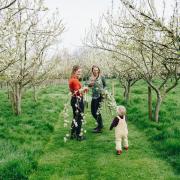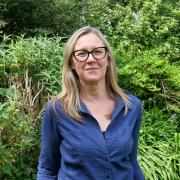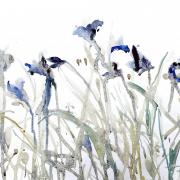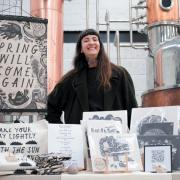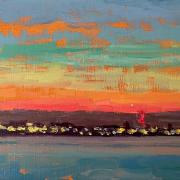Home is where the heart is for illustrator Sam Hiscock and that means Southampton. It has allowed him to learn and grow as an artist and have his work exhibited all over the world, as he tells Sandra Smith

Minutes into this month’s interview I encounter the sort of psychological paraphernalia which stokes my fascination for dissecting behaviour and analysing motive. Obsession, OCD, hoarding – what a dream trio, a troika of actions and attitudes. Oh, how readily distraction beckons. Yet I stick to my remit, soon appreciating that, intrigue for the onlooker aside, such fixations are responsible for wider repercussions which shape the everyday life, and lie at the heart of Sam Hiscock’s work and career.
“I’m obsessed with drawing,” the 23 year old says. “I am inspired by most things. I’ve lived in the same house since I was born; my family would entirely agree with me that we are hoarders. I grew up being tidy and was always interested in why you would have things without a reason. I became obsessed with the idea of objects, and collections, owning an object many times when you don’t usually need more than one.”
Sam’s openness is endearing. He is articulate, a stranger to prevarication and animatedly discusses illustration. His artistic journey, however, wasn’t as straightforward.
“At a parents’ evening when I was young a teacher told them, ‘One thing’s for sure, Sam isn’t going to be an artist.’ I didn’t give this much notice but I was never very good at sport like most boys; I used to watch cartoons and read books, seeing things visually as well as enjoying the stories. I’m inspired by Quentin Blake and love children’s books. I’m definitely a child at heart.”
After studying Fine Art, Graphics and Photography at A Level, university held little appeal, partly because of a reluctance to move away from Southampton. He chose, instead, a Foundation year at Eastleigh College - a ‘brilliant” experience’ - before embarking upon an Illustration degree at Solent University. Despite oozing praise for the lecturers, he was half way through this course before feeling settled.
“The course suited me and I could still live at home but I struggled at first. I wasn’t convinced it was where I wanted to be; everyone seemed a lot more enthusiastic than me. I talked to my lecturers who said, go if it’s not for you. I stayed and in the second half of the second year I found it was what I wanted to do and became excited by the idea that, as an illustrator, you often work for yourself so you’re in charge. That appealed to me. I developed relationships with my lecturers and asked the right questions, become more involved. Then in the final year I started talking to agencies and galleries.”
This proactive approach soon bore fruit. The day after submitting an application to The Bright Agency, Sam received a phone call inviting him to meet them. One week and an interview later he was on the company’s books. An exhibition in London followed then an international residency at Solent which resulted in a travelling exhibition (taking in France, Holland and China) in which his autobiographical images are shown alongside work by artists of genres as diverse as architecture, fashion and sculpture.

Meanwhile competition success resulted in Sam, sponsored by Solent, painting a zebra as part of Marwell Zoo’s Zany Zebras conservation project which raised money and awareness for the conservation of an endangered species.
“There were 100 fake zebras and a number of spaces where they were painted, five or six artists at a time in this crazy, weird room full of fibreglass animals. I was next to someone doing a mosaic. My design came to me in a few minutes. I did some research on the Grevy’s zebras which are predominantly found in Kenya and went with the idea of lots of tribal masks. I used collage and mixed media. I don’t often use paints but the zebra had to be painted with something like a boat varnish in order to withstand the elements. The animals, sponsored by different companies, were dotted around Southampton. This was a great thing for me to be part of.”
When the zebras were eventually auctioned Sam’s, which is now located in The Spark at Solent University, raised £1,200 with a smaller, exact copy, fetching over £500. He smiles at memories of the sale. “I wanted to keep the small one. My mum bid until the price went above £50 when she stopped!”
A fondness for animals infiltrates many of Sam’s illustrations. He recalls attending country fairs with his grandad, retains an interest in nature, owns a pet tortoise and watches wildlife programmes. But he can’t be pigeon holed. While feeling compelled to draw a couple of “ugly” ceramic cats, a row of pencils is just as likely to be captured on paper as old suitcases or spoons. For drawing is a vital way of communicating, recording periods of this artist’s life. And others’ too.
“When an uncle passed away he had 97 years’ worth of stuff, different collections, a lot of which we inherited and I drew.”
Common denominators resurface throughout our discussion. The Bright Agency, Sam enthuses, is not only supportive and nurtures talent, a dog in their office on the day of his interview confirmed to him that they must be nice people. He appreciates this relationship so early on in his career, an opportunity not open to every young illustrator.
Similarly, he takes every opportunity to praise his home city’s Solent University. “My course was fantastic. I got on really well with the Head of Illustration, Jonny Hannah. The course encouraged professional practice, networking, learning to make your own money, the need for business cards and a website. Understanding both the artistic and business sides is important. At the moment I run Solent’s retail store, a great project and brilliant job. I think a lot of it. Illustrators can make and sell things in the store. It’s interesting to explain to students about commission and mark ups. Not all creatives in other universities have that.”
This positive outlook is an aspect his tutor, Jonny Hannah, recalls. “Sam was a very motivated student, and a great storyteller in his work, partly to do with his interesting job on the side, selling junk and objets d’art, and partly to do with his equally interesting family who seem to buy the objets d’art, making a great setting for Sam’s fun and cheeky narratives. But we soon realised that due to Sam being out there in the workplace on market stalls for years, he had an eye for organisation and business too. So not only was he talented in a visual sense, but equally talented in galvanising his fellow students into doing their London exhibition and making it a great success.”
Given his wide ranging interests, which embrace photography and the humour of children’s books, I wonder whether Sam regards himself as an artist or illustrator. After some thought, he declares, “That’s a good question. I always say illustrator. The only difference is the type of person but you can create the same outcome.”
Sam Hiscock may be single minded about drawing but he’s also someone who sees far more in everyday objects, whether functional or decorative, than most of us. Obsessive? Perhaps. Yet such compulsion is the inspiration behind a captivating body of work.






